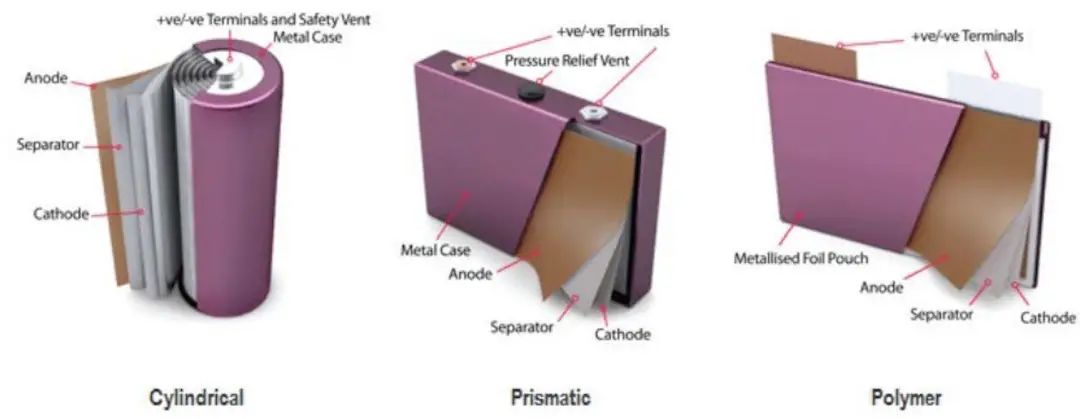Blog
Prismatic vs. Pouch vs. Cylindrical Lithium-ion Battery Cells: Which One Is Right for You?
2025-07-19 | Eric

With the rise of electric vehicles, portable electronics, and energy storage systems, lithium-ion batteries have become the heartbeat of modern technology. But not all lithium-ion batteries are created equal. When it comes to battery cell structure, the three most common types are: Prismatic, Pouch, and Cylindrical cells.
Each of these battery cell formats has its own strengths and weaknesses depending on the application. In this article, we’ll explore the key differences between these three cell types—covering structure, performance, cost, thermal management, and real-world use cases—so you can make an informed decision.
What Is a Prismatic Lithium-ion Battery?
Prismatic cells have a rectangular or box-like shape and are encased in a hard shell, usually made from aluminum or steel. Internally, they use a stacked layer structure, which makes them compact and ideal for systems where space optimization is critical.
✅ Advantages of Prismatic Cells:
- High space efficiency – Flat shape fits well into tight or rectangular spaces.
- Better thermal control – Large surface area supports faster heat dissipation.
- Strong mechanical stability – Durable casing protects against external pressure and vibration.
⚠️ Disadvantages:
- Higher manufacturing cost
- Lower flexibility in cell design
- Inconsistencies in performance at larger capacities can occur
What Is a Pouch Lithium-ion Battery?
Pouch cells use a flexible aluminum-laminated plastic film as casing instead of a rigid metal shell. Internally, they also use a stacked structure but are significantly lighter and more adaptable in shape.
✅ Advantages of Pouch Cells:
- Lightweight and compact – No heavy metal casing
- Flexible design – Can be customized in size and shape
- High energy density – Offers more capacity per unit volume
⚠️ Disadvantages:
- Weaker structural integrity – Prone to swelling or leakage
- Requires advanced battery management systems
- Less stable under high-temperature conditions
What Is a Cylindrical Lithium-ion Battery?
Cylindrical cells are the most established format, widely used since the early commercialization of lithium-ion batteries. Their jelly-roll (wound) internal design is housed in a cylindrical metal casing—common sizes include 18650 and 21700.
✅ Advantages of Cylindrical Cells:
- Mature manufacturing process – High consistency and reliability
- Cost-effective – Ideal for mass production
- Strong mechanical protection – Resistant to pressure and vibration
⚠️ Disadvantages:
- Lower space utilization due to round shape
- Heat dissipation is less efficient
- Limited shape flexibility
Summary Comparison Table: Prismatic vs. Pouch vs. Cylindrical Cells
| Feature | Prismatic Cell | Pouch Cell | Cylindrical Cell |
|---|---|---|---|
| Shape | Rectangular or boxy | Flexible, can be shaped | Cylindrical (tube-like) |
| Space Efficiency | High | Moderate | Low |
| Energy Density | High | Very high | Moderate |
| Weight | Moderate | Very lightweight | Moderate |
| Cost | Higher | Medium | Lowest |
| Thermal Management | Good | Poor | Poor |
| Durability | Strong | Weak | Strong |
| Design Flexibility | Low | High | Low |
| Typical Applications | Electric vehicles, energy storage systems | Smartphones, drones, wearable electronics | Laptops, power tools, flashlights |
Application Scenarios
Prismatic cells are widely used in electric vehicles and stationary energy storage systems. For example, some Tesla models and BYD’s Blade Battery use prismatic structures for better energy packing and safety.
Pouch cells are often found in consumer electronics like smartphones, drones, and tablets, where lightweight and flexible form factors are crucial.
Cylindrical cells dominate in power tools, e-bikes, laptops, and even home energy systems, thanks to their durability and cost-effectiveness.
How to Choose the Right Cell Type?
When selecting the appropriate battery cell, consider the following:
- Space design – Is your product tight on space or oddly shaped?
- Weight sensitivity – Does your application require ultra-lightweight batteries?
- Thermal performance – Can the system manage heat effectively?
- Cost and budget – How price-sensitive is the end product?
- Safety and reliability – Are high durability and safety paramount?
Example:
If you're building an electric vehicle that demands high energy density and thermal control, prismatic cells might be your best bet. On the other hand, if you're designing a drone or Bluetooth headset where light weight is everything, pouch cells offer more value. For power tools or e-bikes, cylindrical cells are usually the go-to option due to their rugged design and affordability.
Conclusion
In the world of lithium-ion batteries, no single cell format is best for all applications. Each type—prismatic, pouch, or cylindrical—has its own unique pros and cons.
Understanding the technical differences and how they align with your specific needs can help you make smarter design and sourcing decisions. Whether you're building the next electric car, designing a compact wearable, or powering industrial tools, choosing the right battery cell is a critical step toward performance, safety, and profitability.
Popular Articles
Contact Details
Worktime :Monday to Friday 9am - 6pm (HKT)
WhatsApp/Wechat/Mobile :+86XXXXX
Email : info@lifepo4cellstore.com
